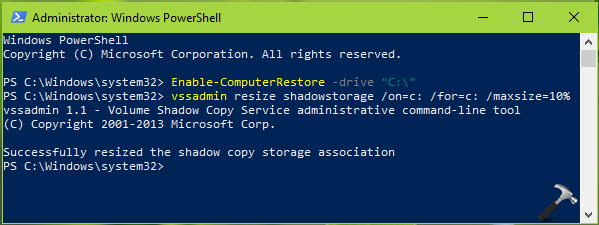
- #TURNING ON SYSTEM PROTECTION IN SYSTEM RECOVERY WINDOWS 10 HOW TO#
- #TURNING ON SYSTEM PROTECTION IN SYSTEM RECOVERY WINDOWS 10 UPDATE#
- #TURNING ON SYSTEM PROTECTION IN SYSTEM RECOVERY WINDOWS 10 WINDOWS 10#
- #TURNING ON SYSTEM PROTECTION IN SYSTEM RECOVERY WINDOWS 10 FREE#
#TURNING ON SYSTEM PROTECTION IN SYSTEM RECOVERY WINDOWS 10 WINDOWS 10#
To access the Windows 10 Advanced startup environment to use System Restore, use these steps:Īs soon as the Windows logo appears on the screen, press the power button to interrupt the boot sequence. If the computer does not start correctly, you can use Advanced startup settings to access the System Restore feature to recover your Windows 10 installation. Undo system changes from Advanced startup If one or more apps were affected, remember to reinstall them again after the recovery process. Once you complete the steps, System Restore will apply the restore point returning the computer to the previous good working state. Click the Scan for affected programs button to confirm the apps that will be removed because they were added after creating the restore point.Select the restore point to undo changes and fix problems on Windows 10. Quick note: If the option is grayed out, it means that the system does not have any restore point available. If you have access to the Windows 10 desktop, you can revert the system changes using these steps: You can complete this task from the Windows 10 desktop or the advanced startup settings if the computer no longer starts correctly. If something unexpected happens after installing or modifying system settings, you can use System Restore to apply a restore point to undo the changes and fix the problem.
#TURNING ON SYSTEM PROTECTION IN SYSTEM RECOVERY WINDOWS 10 HOW TO#
How to recover using System Restore on Windows 10 Type a descriptive name for the restore point - for example, before modifying the Registry settings.Īfter you complete the steps, you should be able to undo system changes in the event that something happens while installing a new driver, program, or applying changes to the Registry. Under the "Protection Settings" section, click the Create button.

However, if you plan to make configurations manually, you always want to create a restore point manually.


Once System Restore is enabled, it will create a checkpoint when it detects system changes automatically. How to create a System Restore point on Windows 10 Only remember that the feature is meant to undo settings changes. If you have additional hard drives, you must enable the protection feature manually on each one. When configuring System Restore, know that this is not a feature you can enable globally.
#TURNING ON SYSTEM PROTECTION IN SYSTEM RECOVERY WINDOWS 10 UPDATE#
Once you complete the steps, Windows 10 will automatically create a restore point when applying a new update or when specific system changes are made.
#TURNING ON SYSTEM PROTECTION IN SYSTEM RECOVERY WINDOWS 10 FREE#
You will also find a Delete button, which you can use to remove all restore points, which can come in handy to free up space or want to start over with the recovery feature. However, under the "Disk Space Usage" section, you can also use the slider to specify the storage amount to use for recovery. Quick tip: Windows 10 can automatically manage the space. Select the Turn on system protection option. Under the "Protection Settings" section, select the main "System" drive.Search for Create a restore point and click the top result to open the System Properties page.To enable System Restore on Windows 10, use these steps: Windows 10 does not have System Restore turned on by default, and you must enable it manually within Control Panel. How to enable System Restore on Windows 10 How to recover using System Restore on Windows 10.How to create a System Restore point on Windows 10.How to enable System Restore on Windows 10.In this Windows 10 guide, we walk you through the steps to set up System Restore as well as the steps to recover from problems that may be affecting the normal operation of a computer.


 0 kommentar(er)
0 kommentar(er)
